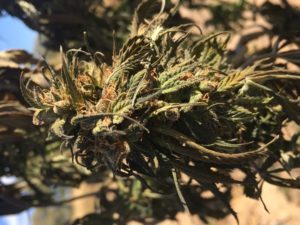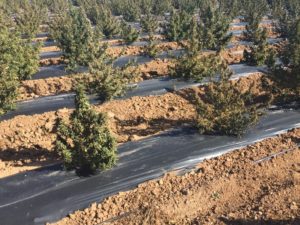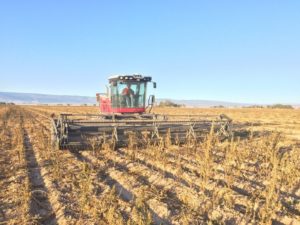Dr. Calvin Trostle, Extension Agronomy, TAMU Soil & Crop Sciences, Lubbock, TX
(806) 723-8432, ctrostle@ag.tamu.edu
October 31, 2019
On Tuesday, October 29 USDA released their interim rules which Texas and other states will now use in crafting their state-specific guidelines for hemp production. I have not read the document yet (161 pages), but it is available at https://www.farmers.gov/manage/hemp then click on “Hemp Production Webpage.” There you will find a link to read or download “Interim Final Rule” in PDF.
Texas A&M AgriLife Extension ag law specialist Tiffany Dowell-Lashmet, JDA, Amarillo, has written an extensive blog post about numerous key points of the proposed rules for industrial hemp, see
https://agrilife.org/texasaglaw/2019/10/29/usda-interim-final-hemp-rule-summary/
Now Texas Dept. of Agriculture will work to finalize Texas rules, which must then be submitted to USDA for federal approval. I have not heard yet a projection from TDA about the time frame going forward for initial applications for industrial hemp grower permits. Some speculate this might be as little as 90 days.
I listened in on a short USDA conference call to highlight some of the federal provisions and answer questions. A couple of points that stood out to me on the call:
• You must have a production contract to apply for Whole Farm Revenue Protection crop insurance, which will be widely available in 2020. Also, must have five years (most recent five years?) with farm income (I assume on any crop).
• Some of the decisions on where to sample hemp plants for THC and how these are handled may be left to states?
• There are already 150+ labs that have the stipulated certification to conduct tests for THC.
• There will be the rules then there will be an addendum. The rules can’t be easily changed. An addendum that advises the rules can, so USDA (or states?) can have a separate set of guidelines that can be flexible and changed if needed.
• I noticed this first in the Texas legislative bill that was signed that there is a “negligence” provision in there. It is also in the USDA 2018 Farm Bill. In this case, from the Texas bill I didn’t understand what they meant. Now it appears that “negligence” may be having THC > 0.5% three years out of five. If this occurs, then the farmers will be banned from growing hemp for five years. (I see a problem with this: if larger farmer has five fields a year for five years, but just one of any fields tests hot three years out of five, or a total of as little as 3 positives for THC out of 25 possible, then is he or she out of hemp for five years?
It is one thing now to have forthcoming rules, but think about this: with such a large state as Texas there could potentially, from an agronomic perspective, be industrial hemp plantings in early spring. Let’s say a farmer could plant somewhere in Texas by March 15. Within about four months from that point (July 15), depending on the type of production, will there be processing facilities—about 9 months from now!—in place to handle an new 2020 Texas hemp crop?
Additional Colorado & New Mexico Farm Visits
I visited hemp harvest in eastern New Mexico, Colorado’s western slope, and revisited another southeast Colorado farm. The Colorado farms were dealing with severe freezes that prematurely dried out their crops (Figs. 1, 2, & 3). So now for CBD harvest, they have a situation that is not unlike an alfalfa farmer trying to manage harvest to keep the leaves on the plant during baling. This means swathing (Fig. 4) and combing (or handling by hand) when humidity is up. Dried floral structures and the all-important trichomes where the highest concentration of CBD resides create fine material and dust, which is lost at harvest. I saw several fields in western Colorado that appeared to have inadequate plans for how they would harvest, transport, and dry their hemp crops. Also, for all the money that it costs to grow
Figs. 1 & 2. Industrial hemp for CBD production that was caught by a harsh freeze in western Colorado, Oct. 9, 2020. The important floral structures now pulverize vs. the controlled drying conditions of harvesting and transporting a normal crop. Dry material most likely the highest in the plant’s CBD will be lost in handling.
Fig. 3. An industrial hemp crop awaiting hand harvest after a freeze. Plants will in a normal field like this with just a few acres would probably be cut by hand and hung to dry. Larger fields are harvested mechanically.
Fig. 4. Colorado hemp harvesting by swather after a freeze. A draper header drops the plants in a row for baling in this case. This is relatively poor field, made worse by a recent field. The hemp plants in this field at no time will be handled by hand.
hemp and the potential for still substantial revenue (though it appears CBD prices are down by 1/3 and even 40% for some farmers compared to a year ago—evidence of a great increase in supply that might be outstripping demand, you would think that farmers would absolutely be on top of their crop management to ensure everything is taken care of. But I saw fields that it looks like farmers had cut corners on, and probably to their financial detriment.
In this regard, one online hemp industry newsletter recently made these points about industrial hemp for CBD production in 2019:
A concerning number of farmers still don’t seem to know how they are getting their crops out of the field and dried. Many are crossing their fingers for a solution to present itself at the last minute. Mother nature could still do serious damage (CLT: and the freezes I saw in Colorado have done just that).
One of the largest farming and processing companies in Kentucky has hit a roadblock in their expansion project (CLT: I believe this is the group that is suing an Oregon seed company for $44 million for lost revenue due to the purchase of > 6 million seed that were not what they were claimed to be, and barely grew). The effect is rippling to farmers and operators across the Kentucky. Many growers didn’t plan on equipment or crews to get their crops harvested, dried, and processed.
There are many ways to grow industrial hemp
As you read more about industrial hemp production and learn about how different farmers approach it, you will notice a wide variation in practices. Some farmers are adamant that hemp must be grown “their way.” Here are the main contrasting approaches I see for CBD production:
Seed type: Planting straight-run seed (meaning field will have males and female plants; some growers rogue the males out and some don’t—if you are following hemp production for CBD you have probably heard that you cannot have male plants in or even near the field), feminized seed, transplants (of feminized seed), clones. This represents a wide range of cost.
CBD content in dried material: at little as 2% (a few extractors will handle this material due to economic considerations) to ~14% for high-yield flower. Mechanized ‘big ag’ may approach a cap on CBD in harvested material in the 8-10% range (because they are harvesting most or all of the plant vs. hand harvest), though many production systems are highly viable for the grower and the processor at 5-6% CBD and maybe even less. Pampered and hand harvest hemp for CBD might be up to 14%.
Planting pattern: 5’ rows with 5’ between plants (~1,750 plants per acre), 30” rows with seeds 24” apart, even drilled.
Irrigation: Surface drip irrigation under a plastic sheet (helps control weeds, Fig. 4), pivot irrigation (sprinkler during establishment then LEPA drag socks), even furrow irrigation. What about dryland? This might be viable in Texas where it rains less than 25” a year for fiber, but I am doubtful about the viability and the risk you face if you are growing for CBD in a dry region without irrigation. Remember, stresses on the hemp plant are believed to increase THC levels.
Harvest: By hand—harvest and hanging up to dry vs. mechanical handling, threshing out floral structures; increasing levels of mechanization to the point that hands never touch the crop in harvest, baling, drying, threshing out any seed, etc.
Upcoming Texas A&M AgriLife Extension Programs with Hemp
I will be involved in the following industrial hemp education programs in Texas that are currently scheduled through December:
• November 5, Wichita Falls. A six-hour program that also includes a Colorado hemp farmer, ag. extension economist, Texas Dept. of Agriculture update, etc. Contact Wichita Co. AgriLife Extension, (940) 716-8610 to pre-register. Fee is $50 and registration begins at 8:00 AM
• November 19, Texas A&M AgriLife Research & Extension Center, Weslaco (Lower Rio Grande Valley), registration at 1:00 PM, fee is $20. This two-hour meeting + questions is advertised only through AgriLife channels directed to farmer clientele. Contact (956) 968-5585.
• November 20, Kleberg and surrounding counties. Fall educational event north of Premont, TX. This general local crop program includes one hour of hemp education. Contact Kleberg Co. AgriLife Extension, (361) 595-8566. 8:30 to 1:00 PM? Registration fee?
• November 20, Atascosa and surrounding counties; meeting held in Leming. Identical two-hour event like Weslaco, including no general media advertising. Contact Atascosa Co. AgriLife Extension, (830) 569-0034, registration at 3:00 PM, $20.
• Dec. 3-5, Amarillo Farm Show. Tentatively, conference organizers have asked Texas A&M AgriLife to contribute to a two-hour hemp program both Tuesday & Wednesday, 2-4 PM. On Thursday, the 5th, I will be at the AgriLife Extension booth during the same time to discuss hemp or other farm questions.
• Dec. 11, Harris Co. AgriLife Extension business expo, Houston’s RPG Center (not a farmer- oriented meeting). I will update attendees most likely during the noon hour then available afterward at a central location to visit with attendees. Call Harris Co. AgriLife Extension for conference details, registration, times, etc., (713) 274-0950.
New AgriLife Extension Public Webpage for Hemp Production
Our agency wide public website for hemp is now active, see http://agrilifeextension.tamu.edu/browse/hemp Several new resources will be posted by November 8th.
This Month’s Final Thought on Industrial Hemp in Texas…
My feelings after the recent Colorado & New Mexico October hemp visits on behalf of AgriLife have sobered me. The novelty of industrial hemp has worn off (and we haven’t grown any yet). The ‘fun’ for me about learning something new is largely over. Reality is setting in just how complicated this is. A hemp farmer in a nearby state says this is the hardest thing he has ever done (decision making, getting good quality seed, sorting out conflicting information on who to trust for contracting with a buyer, harvesting, drying, accepting the high costs of production).
With the uncertainty on licenses in Texas, by the time we get word on licenses for Texas in 2020, the good seed is mostly likely already booked. Fighting field issues including weeds. Figuring out how you are going to do this. One farmer in the Delta, CO region had a modest 50 acres and hired the labor to cut plants then haul the plants to a large warehouse for drying. He filled it up with just 2 acres of his cuttings. Arranging how you will cut the hemp, if not by hand. Big ag. has already moved to mechanical harvests, but then there is needed drying; if you do it in the field too long, imagine a too-dry alfalfa crop losing all its leaves when you go to bale it). Then processing. One out-of-state group in western Colorado planted 1,000 acres of first-time production in 2019, and they had NO plans in place for how they would harvest and dry. A couple of farmers were about done with their own crop and said they’d try to help. Then they had a hard freeze Oct. 9 at 19°F, then the crop is dead and drying down and will crumble off much of the finest parts (with highest CBD) when they handle the plants for harvest, drying, and moving on to a CBD extractor.
I will be right alongside fellow Texas farmers as we all learn together about industrial hemp.



